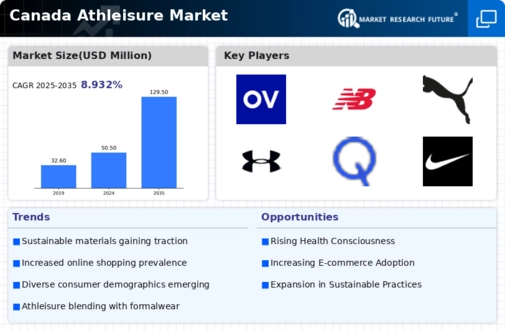The athleisure market exhibits a dynamic competitive landscape characterized by rapid innovation and evolving consumer preferences. Key players such as Lululemon Athletica (CA), Nike (US), and Adidas (DE) are at the forefront, each adopting distinct strategies to capture market share. Lululemon Athletica (CA) focuses on premium product offerings and community engagement, leveraging its strong brand loyalty. Nike (US) emphasizes technological advancements in its product lines, while Adidas (DE) is increasingly investing in sustainability initiatives, reflecting a broader industry trend towards eco-consciousness. Collectively, these strategies contribute to a competitive environment that is both fragmented and highly competitive, with each player striving to differentiate itself through unique value propositions.
In terms of business tactics, companies are increasingly localizing manufacturing to enhance supply chain efficiency and reduce lead times. This approach not only mitigates risks associated with global supply chain disruptions but also aligns with consumer demand for locally produced goods. The market structure appears moderately fragmented, with several key players holding substantial market shares, yet numerous smaller brands also vying for attention. This fragmentation fosters a competitive atmosphere where innovation and agility are paramount.
In October 2025, Lululemon Athletica (CA) announced the launch of a new line of sustainable athleisure wear, utilizing recycled materials and eco-friendly production methods. This strategic move underscores the company's commitment to sustainability, which resonates with the growing consumer demand for environmentally responsible products. By positioning itself as a leader in sustainable fashion, Lululemon Athletica (CA) not only enhances its brand image but also potentially attracts a broader customer base concerned with environmental issues.
In September 2025, Nike (US) unveiled its latest digital platform aimed at enhancing customer engagement through personalized shopping experiences. This initiative leverages advanced data analytics and AI to tailor product recommendations, thereby improving customer satisfaction and loyalty. The strategic importance of this move lies in Nike's ability to harness technology to create a more immersive shopping experience, which is likely to drive sales and strengthen its market position.
In August 2025, Adidas (DE) entered into a partnership with a leading tech firm to develop smart athleisure products that integrate wearable technology. This collaboration aims to enhance the functionality of athletic wear, appealing to tech-savvy consumers who seek performance-enhancing features. The significance of this partnership is profound, as it positions Adidas (DE) at the intersection of fashion and technology, potentially attracting a new demographic of consumers interested in innovative athletic solutions.
As of November 2025, the athleisure market is increasingly defined by trends such as digitalization, sustainability, and the integration of AI technologies. Strategic alliances are becoming more prevalent, enabling companies to pool resources and expertise to innovate more effectively. Looking ahead, competitive differentiation is likely to evolve from traditional price-based competition towards a focus on innovation, technological advancements, and supply chain reliability. This shift suggests that companies that prioritize these areas will be better positioned to thrive in an increasingly competitive landscape.

























Leave a Comment